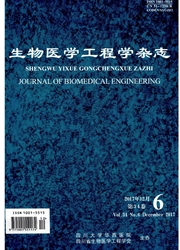

 中文摘要:
中文摘要:
卵母细胞在低温保护剂的加载和去除过程中,会受到渗透损伤和毒性损伤,采用微流控技术可实现保护剂浓度连续变化,减小细胞损伤。本文设计了用于低温保护剂加载及去除的5种不同参数的Y型微流控芯片,测定了在不同入口流速、芯片入口角度、通道深宽比及转弯半径下,微通道内保护剂溶液和缓冲溶液的混合程度。实验结果表明:随着溶液入口流速的减小、通道深宽比的增大及转弯半径的减小,溶液在微通道内混合长度减小,混合速度加快,而微通道入口角度对流体混合影响很小。但实际芯片的操作条件及结构参数应根据低温保护剂加载和去除时需要达到的效果以及芯片加工工艺等因素确定。本文研究结果可为其他用于低温保护剂混合的微流控芯片的设计提供参考。
 英文摘要:
英文摘要:
Microfluidic chips can be used to realize continuous cryoprotectants (CPA) loading/unloading for oocytes, reducing osmotic damage and chemical toxicity of CPA. In this study, five different Y-shape microfluidic chips were fabricated to realize the continuous CPA loading/unloading. The effects of flow rate, entrance angle, aspect ratio and turning radius of microchannels on the mixing efficiency of microfluidic chips were analyzed quantitatively. The experimental results showed that with the decrease of flow rates, the increase of aspect ratios and the decrease of turning raradius of microchannel, the mixing length decreased and the mixing velocity was promoted, while the entrance angle had little effect on the mixing efficiency. However, the operating conditions and structural parameters of the chips in practical application should be determined based on an overall consideration of CPA loading/unloading time and machining accuracy. These results would provide a reference to the application of microfluidic chip in CPA mixing.
 同期刊论文项目
同期刊论文项目
 同项目期刊论文
同项目期刊论文
 期刊信息
期刊信息
